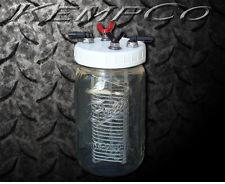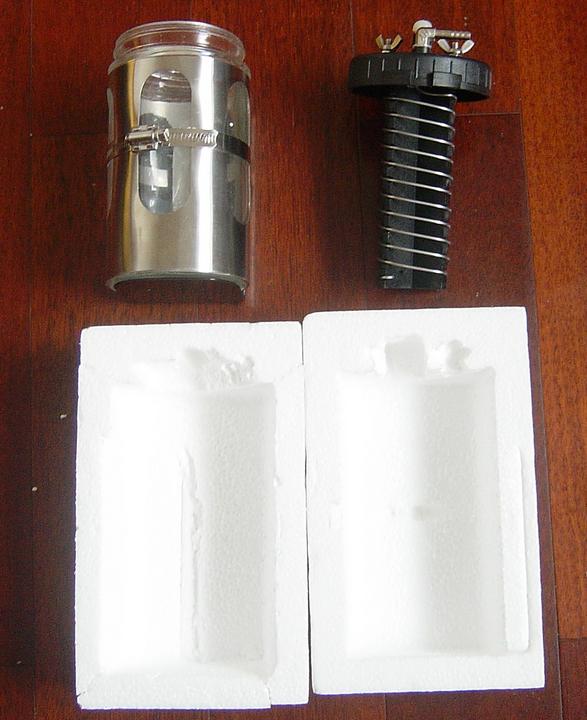|
High quality Jar Cells for sale; below manufacturing
cost.
These are by far the best constructed Jar Cells available. They can be
used to make "Charged Water" or to make "Humidity & HHO Gas".
The Jar Cell is credited for spreading the
HHO movement. They are not capable of producing large quantities
of HHO gas. They do not have enough surface area on the electrodes to do
that. By design, they produce a humidity that benefits fuel burn in
gasoline and diesel engines. The wires heat the water, which produces
the humidity; in the process, water molecules are separated into
hydrogen and oxygen bubbles (HHO). The humidity and the HHO is
then fed into the engines air way so that it gets sucked into the
combustion chambers as part of the metered air and fuel mix. The added
oxygen leans out the fuel ratio, which causes fuel to burn more
completely, but it increases heat. However, the humidity has a cooling
effect that lowers combustion temperatures and gets pressurized into
steam. As for the hydrogen, well it burns other fuels around it. The
process happens without the need to fool the engine computer.
By design, this Jar Cell operates on low
amperage. The diameter of the wire electrodes limits the amount of
electrical current that it passes. If too much current is allowed, the
water will boil and the wires will deteriorate because of electron
bombardment. These cells should be operated using about 3 amps. Their
primary purpose is to heat the water and produce humidity for the
engine. HHO is a by-product of the process.
One nice feature about this Jar Cell is the
stainless steel housing. It helps protect and contain the glass. As for
the Lid, it is strong, thick, made to last.
Most installations consist of a single Jar
Cell operating on a 12 volt system. If you want to increase your output,
consider adding more cells. If you do so, consider wiring them in
Series. Series will increase the efficiency of the cell by lowering the
operating voltage to each cell.
Place your Positive wire on this end (+
-)-----(+ -)-----(+ -) and your Negative wire on this end. That wires 3
cells in a series.
Available quantity: 3,000 Units (the molds can also be
purchased)
- Each Jar Cell is constructed with all 316L stainless steel;
glass protector, wing-nuts, washers, bolts, wire.
- Each Jar Cell is equipped with an adjustable mounting bracket.
- The Jar Lids are Heavy Duty, quality, injection molded, and are
designed not to leak.
- The Wire Mount assembly is Heavy Duty Injection Molded.
- The Cell Holder is injection molded.
- Each Jar is assembled; and equipped with a Wire Cell.
- Each Cell is packaged in Styrofoam for safe shipping. (single or
three pack)
- The complete inventor will ship FOB from L.A. (Free 150cm tubing for each cell if you buy all of the
jars; also includes about 300 extra pieces of 316L wire sets for
free)
Pricing: There is an opportunity to purchase these Cells at a
little more than $13 each. You can not purchase the parts and assemble
them for that price.
(The seller is not interested in selling less than 1000 units at a time)
- All inventory for $40,000 (does not include the molds) (Make an offer)
- 1,000 Units for $15,000 (that is $15 per unit)
- Buy the Lid Mold for $4,000 (you can not have it made for that
price)
- Buy the Wire Tower Mold for $5,000 (you can not have it made for
that price)
Shipping:
- At present, the customer pays all shipping costs from Taiwan
Warranty:
- All Sales are Final (Inventory Clearance).
Contact: Due to language interpretations, I am mediating
contact between you and the seller; at the sellers request. I know the
seller personally. I assure you he is honorable. For inquiries, please
contact me via the mail link below.
mailto:david@hho4free.com
|

This Jar Cell is so well constructed,
it could easily be used to house stainless steel flat plates; in other
words, convert it from a wire cell to a flat plate cell, or even a tube
cell. I have an interest in converting it to Fog Vapor injection. The
Fog could be created from water, alcohol, gasoline, kerosene, diesel
fuel; etc. It could easily be accomplished using an ultrasonic
transducer to vibrate the liquid into vapor.
9 out of 10 companies that produce
Hydrogen Generators (HHO) will tell you Jar Cells are not safe; never
use them. Admittedly, I am guilty of that. However, when considering how
this Jar Cell is used, and how it is constructed, glass becomes an
asset. Chuck uses thick glass jars than can withstand the heat and light
impact. He also protects the glass with the stainless steel housing. If
it were to break, the housing and mounting bracket would contain most of
the glass.
The windows in the housing allow
us to inspect what is going on inside the jar. One thing is certain, the
glass will not melt, thus the jar will not leak.
I will put my reputation on the
line by stating "this jar cell is safe to use as long as it is used as
intended. That is, it is used to create humidity --- with a by-product
of HHO. It is not primarily an HHO generator. HHO generators require a
lot of amperage and a lot of surface area for that amperage. Wire Cells
can efficiently produce humidity, but they can not efficiently produce
HHO.
If you intend to use this product
primarily as an HHO generator, then replace the wire electrodes with
flat plates or tubes. The wire strands are heating elements, not HHO
plates. The wires will deteriorate quickly if excess amperage is used to
generate HHO. Be prepared to encounter changes that the engine computer
may compensate for. |
 |
These cells are assembled using
Solid 316L stainless steel wire.
Some companies use stranded stainless
steel wire. They say it increases surface area, it does do that, but all
of that surface area does not touch the water; only the outside layer
touches the water. Stranded wire provides more surface area for
electrical current to pass over, but it provides less surface area for
HHO production. Stranded wire will also cause foaming; each strand is
lubricated as it is manufactured. When oil is mixed with electrolytes
such as KOH and NaOH, it produces soap suds, hence foam.
It is also important to know that
the surface area of each strand is smaller than the surface area of
solid wire. Electron bombardment will deteriorate the stranded layers
more quickly. The result will be metal strand particles falling to the
bottom of the cell. Of course this happens over time, but it happens.
Something else to consider;
stranded wire is flexible. If the water gets hot enough, the plastic
tower that holds the strands together will soften, and possibly melt.
The stranded wires will loose there shape and possibly short together
(stranded has a tendency to straighten. Solid wire, however, will hold
its shape. It is less likely to short.
Yet still more consideration
should be given to the distance between wire electrodes. Both solid and
stranded conduct the most HHO in the areas that are closest between the
2 electrodes. With stranded however, that surface level varies by the
depth of the strands. That will result in most of the HHO being produced
by the closer strand surfaces. That variance will affect gas production
in the same way flat plates and tubes are affected when they are not
spaced equally. Solid wire has an advantage, although it is small. |